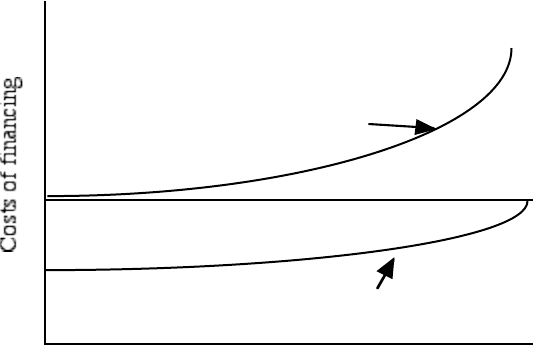Damodaran A. Applied corporate finance
Подождите немного. Документ загружается.


58
58
businesses because
technological change
makes future investment
uncertain.
well established.
investments are limited.
Based upon this analysis, qualitative though it might be, we would argue that all three
firms could benefit from borrowing, as long as the borrowing does not push it below an
acceptable default risk threshold.
No Optimal Capital Structure
We have just argued that debt has advantages, relative to equity, as well as
disadvantages. Will trading off the costs and benefits of debt yield an optimal mix of debt
and equity for a firm? In this section, we will present arguments that it will not, and the
resulting conclusion that there is no such optimal mix. The seeds of this argument were
sown in one of the most influential papers ever written in corporate finance, containing
one of corporate finance’s best-known theorems, the Modigliani-Miller Theorem.
When they first looked at the question of whether there is an optimal capital
structure, Miller and Modigliani drew their conclusions in a world void of taxes,
transactions costs, and the possibility of default. Based upon these assumptions, they
concluded that the value of a firm was unaffected by its leverage and that investment and
financing decisions could be separated. Their conclusion can be confirmed in several
ways; we present two in this section. We will also present a more complex argument for
why there should be no optimal capital structure even in a world with taxes, made by
Miller almost two decades later.
The Irrelevance of Debt in a Tax-free World
In their initial work, Miller and Modigliani made three significant assumptions
about the markets in which their firms operated. First, they assumed there were no taxes.
Second, they assumed firms could raise external financing from debt or equity, with no
issuance costs. Third, they assumed there were no costs –direct or indirect – associated
with bankruptcy. Finally, they operated in an environment in which there were no agency
costs; managers acted to maximize stockholder wealth, and bondholders did not have to
worry about stockholders expropriating wealth with investment, financing or dividend
decisions.

59
59
In such an environment, reverting back to the trade off that we summarized in
Table 7.3, it is quite clear that all the advantages and disadvantages disappear, leaving
debt with no marginal benefits and no costs. In Table 18.5, we modify table 18.1 to
reflect the assumptions listed above:
Table 7.6: The Trade Off on Debt: No Taxes, Default Risk and Agency Costs
Advantages of Debt
Disadvantages of Debt
1. Tax Benefit:
Zero, because there are no taxes
1. Bankruptcy Cost:
Zero, because there are no bankruptcy
costs
2. Added Discipline:
Zero, because managers already maximize
Stockholder wealth.
2. Agency Cost:
Zero, because bondholders are fully
protected from wealth transfer
3. Loss of Future Financing Flexibility:
Not costly, because firms can raise
external financing costlessly.
Debt creates neither benefits nor costs and thus has a neutral effect on value. In such an
environment, the capital structure decision becomes irrelevant.
In a later paper, Miller and Modigliani preserved the environment they introduced
above but made one change, allowing for a tax benefit for debt. In this scenario, where
debt continues to have no costs, the optimal debt ratio for a firm is 100% debt. In fact, in
such an environment the value of the firm increases by the present value of the tax
savings for interest payments (See Figure 18.4).
Value of Levered Firm = Value of Unlevered Firm + t
c
B
where t
c
is the corporate tax rate and B is the dollar borrowing. Note that the second term
in this valuation is the present value of the interest tax savings from debt, treated as a
perpetuity. Figure 7.8 graphs the value of a firm with just the tax benefit from debt.

60
60
V
u
V
L
t
c
B
Firm
Value
Debt ($ B)
Figure 7.8: Value of Levered Firm: MM with Taxes
Tax Benefit of borrowing
Miller and Modigliani presented an alternative proof of the irrelevance of leverage,
based upon the idea that debt does not affect the underlying cash flows of the firm, in the
absence of taxes. Consider two firms that have the same cash flow (X) from operations.
Firm A is an all-equity firm, while firm B has both equity and debt. The interest rate on
debt is r. Assume you are an investor and you buy a fraction(α) of the equity in firm A,
and the same fraction of both the equity and debt of firm B. Table 7.7 summarizes the
cash flows that you will receive in the next period.
Table 7.7: Cash Flows to Investor from Levered and All-Equity Firm
Firm A Firm B
Type of firm All-Equity firm (V
u
= E) Has some Equity and Debt
Actions now Investor buys a fraction a of
Investor buys a fraction a of
the firm (α V
u
) both equity and debt of the
firm
α E
L
+ α D
L
Next period Investor receives a fraction a Investor receives the following
of the cash flow (α X) α(X-rD
L
) + α r D
L
= α X
Since you receive the same total cash flow in both firms, the price you will pay for either
firm has to be the same. This equivalence in values of the two firms implies that leverage
does not affect the value of a firm. Note that this proof works only if the firm does not
61
61
receive a tax benefit from debt; a tax benefit would give Firm B a higher cash flow than
Firm A.
The Irrelevance of Debt with Taxes
It is clear, in the Miller-Modigliani model, that when taxes are introduced into the
model, debt does affect value. In fact, introducing both taxes and bankruptcy costs into
the model creates a trade off, where the financing mix of a firm affects value, and there is
an optimal mix. In an address in 1979, however, Merton Miller argued that the debt
irrelevance theorem could apply even in the presence of corporate taxes, if taxes on the
equity and interest income individuals receive from firms were included in the analysis.
To demonstrate the Miller proof of irrelevance, assume that investors face a tax
rate of t
d
on interest income and a tax rate of t
e
on equity income. Assume also that the
firm pays an interest rate of r on debt and faces a corporate tax rate of t
c
. The after-tax
return to the investor from owning debt can then be written as:
After-tax Return from owning Debt = r (1-t
d
)
The after-tax return to the investor from owning equity can also be estimated. Since cash
flows to equity have to be paid out of after-tax cash flows, equity income is taxed twice –
– once at the corporate level and once at the equity level:
After-tax Return from owning Equity = k
e
(1 - t
c
) (1 - t
e
)
The returns to equity can take two forms –– dividends or capital gains; the equity tax rate
is a blend of the tax rates on both. In such a scenario, Miller noted that the tax benefit of
debt, relative to equity becomes smaller, since both debt and equity now get taxed, at
least at the level of the individual investor.
Tax Benefit of Debt, relative to Equity = {1 - (1-t
c
) (1-t
e
)}/(1-t
d
)
With this relative tax benefit, the value of the firm, with leverage, can be written as:
V
L
= V
u
+ [1- (1-t
c
) (1-t
e
))/(1-t
d
)] B
where V
L
is the value of the firm with leverage, V
U
is the value of the firm without
leverage, and B is the dollar debt. With this expanded equation, that includes both
personal and corporate taxes, there are several possible scenarios:
62
62
a. Personal tax rates on both equity and dividend income are zero: if we ignore
personal taxes, this equation compresses to the original equation for the value of a
levered firm, in a world with taxes but no bankruptcy costs:
V
L
= V
u
+ t
c
B
b. The personal tax rate on equity is the same as the tax rate on debt: If this were the
case, the result is the same as the original one –– the value of the firm increases
with more debt.
V
L
= V
u
+ t
c
B
c. The tax rate on debt is higher than the tax rate on equity: In such a case, the
differences in the tax rates may more than compensate for the double taxation of
equity cash flows. To illustrate, assume that the tax rate on ordinary income is
70%, the tax rate on capital gains on stock is 28% and the tax rate on corporations
is 35%. In such a case, the tax liabilities for debt and equity can be calculated for
a firm that pays no dividend as follows:
Tax Rate on Debt Income = 70%
Tax Rate on Equity Income = 1 - (1-0.35) (1-.28) = 0.532 or 53.2%
This is a plausible scenario, especially considering tax law in the United States
until the early 1980s. In this scenario, debt creates a tax disadvantage to investors.
d. The tax rate on equity income is just low enough to compensate for the double
taxation: In this case, we are back to the original debt irrelevance theorem.
(1 - t
d
) = (1-t
c
) (1-t
e
) ................ Debt is irrelevant
Miller’s analysis brought investor tax rates into the analysis for the first time and
provided some insight into the role of investor tax preferences on a firm’s capital
structure. As Miller himself notes, however, this analysis does not reestablish the
irrelevance of debt under all circumstances; rather, it opens up the possibility that debt
could still be irrelevant, despite its tax advantages.
The Consequences of Debt Irrelevance
If the financing decision is irrelevant, as proposed by Miller and Modigliani,
corporate financial analysis is simplified in a number of ways. The cost of capital, which
is the weighted average of the cost of debt and the cost of equity, is unaffected by

63
63
changes in the proportions of debt and equity. This might seem unreasonable, especially
since the cost of debt is much lower than the cost of equity. In the Miller-Modigliani
world, however, any benefits incurred by substituting cheaper debt for more expensive
equity are offset by increases in both their costs, as shown in Figure 7.9.
Cost of Equity
Cost of Debt
Cost of Capital
Figure 7.9: Cost of Capital in the MM World
Debt Ratio
Cost of equity rises as
leverage increases
Cost of debt rises as
default risk increases
The value of the firm is also unaffected by the amount of leverage it has. Thus, if the
firm is valued as an all-equity entity, its value will remain unchanged if it is valued with
any other debt ratio. (This actually follows from the implication that the cost of capital is
unaffected by changes in leverage and from the assumption that the operating cash flows
are determined by investment decisions rather than financing decisions.)
Finally, the investment decision can be made independently of the financing decision.
In other words, if a project is a bad project when evaluated as an all-equity project, it will
remain so using any other financing mix.
The Contribution of the Miller-Modigliani Theorem
It is unlikely that capital structure is irrelevant in the real world, given the tax
preferences for debt and existence of default risk. In spite of this, Miller and Modigliani
were pioneers in moving capital structure analysis from an environment in which firms
picked their debt ratios based upon comparable firms and management preferences, to
one that recognized the trade-offs. They also drew attention to the impact of good
investment decisions on firm value. To be more precise, a firm that invests in poor

64
64
projects cannot hope to recoup the lost value by making better financing decisions; a firm
that takes good projects will succeed in creating value, even if it uses the wrong financing
mix. Finally, while the concept of a world with no taxes, default risk, or agency problems
may seem a little far-fetched, there are some environments in which the description might
hold. Assume, for instance, that the U.S. government decides to encourage small
businesses to invest in urban areas by relieving them of their tax burden and providing a
back-up guarantee on loans (default protection). Firms that respond to these initiatives
might find that their capital structure decisions do not affect their value.
Finally, surveys of financial managers indicate that, in practice, they do not attach
as much weight to the costs and benefits of debt as we do in theory. In a survey by
Pinegar and Wilbricht, managers were asked to cite the most important inputs governing
their financial decisions. Their responses are ranked in the order of the importance
managers attached to them in Table 7.8.
Table 7.8: Inputs into Capital Structure Decisions
Percentage of Responses Within Each Rank
Least Important...................………...Most Important
Inputs/Assumptions by
Order of Importance
1
2
3
4
5
Not Ranked
Mean
1. Projected cash flow from
asset to be financed
1.7%
1.1%
9.7%
29.5%
58.0%
0.0%
4.41
2. Avoiding dilution of
common equity’s claims
2.8%
6.3%
18.2%
39.8%
33.0%
0.0%
3.94
3. Risk of Asset to be
financed
2.8%
6.3%
20.5%
36.9%
33.0%
0.6%
3.91
4. Restrictive covenants on
senior securities
9.1%
9.7%
18.7%
35.2%
27.3%
0.0%
3.62
5. Avoiding mispricing of
securities to be issued.
3.4%
10.8%
27.3%
39.8%
18.7%
0.0%
3.60
6. Corporate Tax Rate
4.0%
9.7%
29.5%
42.6%
13.1%
1.1%
3.52
7. Voting Control
17.6%
10.8%
21.0%
31.2%
19.3%
0.0%
3.24
8. Depreciation & Other
Tax shields
8.5%
17.6%
40.9%
24.4%
7.4%
1.1%
3.05
9. Correcting mispricing of
securities
14.8%
27.8%
36.4%
14.2%
5.1%
1.7%
2.66
10. Personal tax rates of
debt and equity holders
31.2%
34.1%
25.6%
8.0%
1.1%
0.0%
2.14
11. Bankruptcy Costs
69.3%
13.1%
6.8%
4.0%
4.5%
2.3%
1.58
Financial managers seem to weigh financial flexibility and potential dilution much more
heavily than bankruptcy costs and taxes in their capital structure decisions.
In Practice: The Dilution Bogey

65
65
The dilution effect refers to the possible decrease in earnings per share from any
action that might lead to an increase in the number of shares outstanding. As evidenced in
table 7.8, managers, especially in the United States, weigh these potential dilution effects
heavily in decisions on what type of financing to use, and how to fund projects. Consider,
for instance, the choice between raising equity using a rights issue, where the stock is
issued at a price below the current market price, and a public issue of stock at the market
price. The latter is a much more expensive option, from the perspective of investment
banking fees and other costs, but is chosen, nevertheless, because it results in fewer
shares being issued (to raise the same amount of funds). The fear of dilution is misplaced
for the following reasons:
1. Investors measure their returns in terms of total return and not just in terms of stock
price. While the stock price will go down more after a rights issue, each investor will
be compensated adequately for the price drop (by either receiving more shares or by
being able to sell their rights to other investors). In fact, if the transactions costs are
considered, stockholders will be better off after a rights issue than after an equivalent
public issue of stock.
2. While the earnings per share will always drop in the immediate aftermath of a new
stock issue, the stock price will not necessarily follow suit. In particular, if the stock
issue is used to finance a good project (i.e., a project with a positive net present
value), the increase in value should be greater than the increase in the number of
shares, leading to a higher stock price.
Ultimately, the measure of whether a company should issue stock to finance a project
should depend upon the quality of the investment. Firms that dilute their stockholdings to
take good investments are choosing the right course for their stockholders.
There Is An Optimal Capital Structure
The counter to the Miller-Modigliani proposition is that the trade-offs on debt
may work in favor of the firm, at least initially, and that borrowing money may lower the
cost of capital and increase firm value. We will examine the mechanics of putting this
argument into practice in the next chapter; here, we will make a case for the existence of

66
66
an optimal capital structure, and looking at some of the empirical evidence for and
against it.
The Case for an Optimal Capital Structure
If the debt decision involves a trade-off between the benefits of debt (tax benefits
and added discipline) and the costs of debt (bankruptcy costs, agency costs and lost
flexibility), it can be argued that the marginal benefits will be offset by the marginal costs
only in exceptional cases, and not always (as argued by Miller and Modigliani). In fact,
under most circumstances, the marginal benefits will either exceed the marginal costs (in
which case, debt is good and will increase firm value) or fall short of marginal costs (in
which case, equity is better). Accordingly, there is an optimal capital structure for most
firms at which firm value is maximized.
Of course, it is always possible that managers may be operating under an illusion
that capital structure decisions matter when the reality might be otherwise. Consequently,
we examine some of the empirical evidence to see if it is consistent with the theory of an
optimal mix of debt and equity.
Empirical Evidence
The question of whether there is an optimal capital structure can be answered in a
number of ways. The first is to see if differences in capital structure across firms can be
explained systematically by differences in the variables driving the trade-offs. Other
things remaining equal, we would expect to see relationships listed in Table 7.9.
Table 7.9: Debt Ratios and Fundamentals
Variable
Effect on Debt Ratios
Marginal Tax Rate
As marginal tax rates increase, debt ratios
increase.
Separation of Ownership and Management
The greater the separation of ownership
and management, the higher the debt ratio.
Variability in Operating Cash Flows
As operating cash flows become more
variable, the bankruptcy risk increases,
resulting in lower debt ratios.

67
67
Debt holders’ difficulty in monitoring firm
actions, investments and performance.
The more difficult it is to monitor the
actions taken by a firm, the lower the
optimal debt ratio.
Need for Flexibility
The greater the need for decision making
flexibility in future periods, the lower the
optimal debt ratio.
While this may seem like a relatively simple test to run, keeping all other things equal in
the real world is often close to impossible. In spite of this limitation, attempts to see if the
direction of the relationship is consistent with the theory have produced mixed results.
Bradley, Jarrell and Kim (1984) analyzed whether differences in debt ratios can
be explained by proxies for the variables involved in the capital structure trade-off. They
noted that the debt ratio is:
• negatively correlated with the volatility in annual operating earnings, as predicted by
the bankruptcy cost component of the optimal capital structure trade off
• positively related to the level of non-debt tax shields, which is counter to the tax
hypothesis, which argues that firms with large non-debt tax shields should be less
inclined to use debt.
• negatively related to advertising and R&D expenses used as a proxy for agency costs;
this is consistent with optimal capital structure theory.
Others who have attempted to examine whether cross-sectional differences in capital
structure are consistent with the theory have come to contradictory conclusions.
A second test of whether differences in capital structure can be explained by
differences in firm characteristics involve examining differences in debt ratios across
industries.
An alternate test of the optimal capital structure hypothesis is to examine the
stock price reaction to actions taken by firms either to increase or decrease leverage. In
evaluating the price response, we have to make some assumptions about the motivation
of the firms making these changes. If we assume that firms are rational and that they
make these changes to get closer to their optimal, both leverage-increasing and
decreasing actions should be accompanied by positive excess returns, at least on average.
Smith(1988) notes that the evidence is not consistent with an optimal capital structure
